| Article ID | Journal | Published Year | Pages | File Type |
|---|---|---|---|---|
| 4454048 | Journal of Environmental Sciences | 2015 | 10 Pages |
The immobilization of pre-dispersed TiO2 colloids onto the external surface of the clay mineral montmorillonite (Mt) was accomplished and regulated via a self-assembly method employing the cationic surfactant cetyltrimethylammonium bromide (CTAB). The role of CTAB in the synthesis process was investigated by preparing a series of TiO2-CTAB-Mt composites (TCM) with various CTAB doses. The results indicated that a uniform and continuous TiO2 film was deposited on the external surface of montmorillonite in the composite synthesized with 0.1 wt.% of CTAB, and the TCM nano-composites showed much higher values for specific surface area, average pore size and pore volume than the raw montmorillonite clay. Then, the formed TCM materials were applied in photocatalytic degradation of 2,4-dichlorophenol (2,4-DCP) in aqueous solution. The degradation efficiency reached as high as 94.7%. Based on the degradation intermediates benezoquinone, fumaric acid and oxalic acid identified by LC–MS analysis, a mechanism for the photocatalytic oxidation of 2,4-DCP on TiO2/Mt nano-composites is proposed.
Graphical abstractThe immobilization of pre-dispersed TiO2 colloids onto the external surface of clay minerals montmorillonite (Mt) was accomplished and regulated via self-assembly method employing cationic surfactant cetyltrimethylammonium bromide (CTAB). The role of CTAB in the synthesis process was investigated by preparing a series of TiO2-CTAB-Mt composites (TCM) with diverse CTAB doses. The results indicated that uniform and continuous TiO2 film was deposited on the external surface of montmorillonite in the composite synthesized with 0.1 wt.% of CTAB and the TCM nano-composites showed much higher values for specific surface area, average pore size and pore volume than the raw montmorillonite clay. Then, the formed TCM materials were applied for photocatalytic degradation of 2,4-dichlorophenol (2,4-DCP) in aqueous solution. The degradation efficiency reached up to 94.7%. Based on the degradation intermediates benezoquinone, fumaric acid and oxalic acid identified by LC–MS analysis, the mechanism of photocatalytic oxidation of 2, 4-DCP on TiO2/Mt nano-composites is proposed.Figure optionsDownload full-size imageDownload as PowerPoint slide
